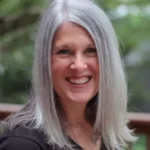The first time I saw Steve Watters I felt a spark. The first time we talked was during a mandatory “how to use the library” tour in grad school; we whispered in the back of the group about the books we were reading. He’s a reader, I thought. An immediate plus. I went out a few days later and bought the book he mentioned so we’d have more to talk about.
Soon after, I noticed there was no newspaper or publication for our school, so I suggested to a couple new friends that we start one. I asked one of the guys to invite Steve, a former yearbook editor, to our upcoming meeting. I thought it would interest him. Thankfully it did, and together we started a webzine at Steve’s suggestion. It wasn’t long before our team of five students was meeting weekly, working on a mission statement for our webzine, getting to know one another and praying together for God’s blessing on our endeavor. It was a natural way to get to know Steve more and a great chance to see him in his element: writing and editing and launching a new project. It didn’t hurt that working together gave him a chance to see my strengths, too.
In the course of a few months, we became very good friends. In addition to all the work meetings and outings, Steve and I found we had a lot in common and started doing things together, just the two of us. We’d go out for coffee or to a bookstore or to the movies. We spent a lot of time talking and learning more about one another. We weren’t dating, and the relationship was platonic. But I was hopeful.
During one memorable outing, we drove to Williamsburg for a day of retreating with the webzine staff. Steve had some music he wanted me to hear, so I rode with him. This is great, I thought. We’ll have an hour to talk and be together — alone. It couldn’t have gone any better. We had a great time on the drive up and even seemed to connect in the midst of the larger group while sightseeing. I was beaming, thinking, Surely he’s getting it now. He must see the chemistry here. As the day wound down, he even arranged for the same caravan partners on the ride home. Another hour alone. This is better than I expected!
We had only been in the car a few minutes when he dropped the bomb: “I’ve got to get back to school,” he said.
“Oh, really. Why?” I asked.
“I’ve got a date with Kelli.”
A date? After our incredible time together today, you have the nerve to tell me you have a date with another woman? I was stunned.
Still, I was falling for him.
Unexpected Help
Steve was a godly, kind and hardworking man. I loved his sense of humor, integrity and intelligence. By summer, we were spending time together every day. He was no longer dating anyone else (that Kelli thing fizzled out after a month or so) and everyone around us thought we were a couple. But I knew there was no commitment for anything more than pals. I was at my wits’ end. Here was the man I wanted to marry, and he seemed oblivious to what a good match we were.
Enter Mary Morken. She was the wife of our professor, Hubert Morken, and had a reputation for matching couples — over 30 to date. The women in our program were eager for an opportunity for the Morkens to tell their story to our classmates, especially the men. We invited them to speak at our class retreat one fall weekend in Virginia. As we gathered around a big stone fireplace, Mary told about how she and Hubert had been close friends at Wheaton many years before. They spent their time in college working together as the social and spiritual leaders of their peer group, but never with a hint of romance. Just before graduation Hubert realized for the first time that Mary was someone special. He said it’s as if a word suddenly flashed, in his mind, across her forehead. The word: wife.
Mary said she had been in love with him all along, but never let on. She prayed God would open his eyes and worked at being the best friend to him she could be. Listening to her speak, I couldn’t help but notice the similarities between her story and mine. I was eager for more information and advice. After they finished, they took questions. In answering, Mary talked about why the times we live in make it so hard for marriages to form. “The culture we live in is anti-marriage,” she said. “So many of the customs and unwritten social rules that once helped bring young men and women together, now seem to pull them apart.”
A light went off in my head — I hadn’t realized what I was up against. Up till then, I thought just praying for a husband was enough. “So what can we do about it?” I asked. Mary responded matter-of-factly: “Sometimes you have to ‘pull a Ruth.'”
“What’s that?” I asked.
She went on to tell us the Old Testament story of Ruth. Set in the time of Judges — some of Israel’s darkest days — Ruth, a widow of an Israelite husband, left her homeland in Moab to follow her mother-in-law, Naomi, to Bethlehem in Israel.
“Ruth lived in a stable society where families were involved in God’s work of bringing mates together,” Mary said. In that regard, our worlds are far apart. “In our day,” she said, “we are in limbo without the structures and social supports. We don’t even know if potential mates believe in marriage the same as we do. Just how courtship should be done is up for grabs.” Ruth didn’t have a stable family, just a widowed mother-in-law. And this is where she has much to teach us.
Naomi took creative and intentional steps to help Ruth marry again. It was Naomi’s idea to send Ruth to the threshing floor to ask Boaz to act the part of “kinsman redeemer.” Translated in modern English, “She was saying in effect, ‘I would like to be the one to whom you pledge your faithfulness and with whom you make a marriage covenant.’John Piper, A Sweet & Bitter Providence (Wheaton, IL: Crossway Books, 2010), 86.
Mary encouraged us to be strategic. “Facilitate the courtship process and express your beliefs about marriage and courtship within your group of friends. You never know; that group may include your future mate. Talk about marriage,” she said. “Don’t be afraid of the subject. You are young, godly men and women; you should want to be married and be willing to do the work to get there.” We were all a little shocked by her boldness and what seemed an unconventional approach. We also knew we weren’t finding any success doing things our way.
The men we knew were passive in the midst of a relationally chaotic society. The women, myself included, were silent about our hopes for marriage, even as we were quite vocal about our plans for getting our degrees and pursuing careers after graduation. Relationally we were stymied.
Pulling a Ruth
I knew Steve and I would make a great couple, but I also knew that everyone thought we were dating. And we weren’t. Steve had given me lots of cues that we would make a good couple, even that he was open to the possibility, but we were stuck. After months of acting like a couple with no progress toward a commitment, it was time to act. On our way to campus the morning before summer break was over, I laid it all on the line. “Steve, I want to get married one day, and I hope it’s to you. But if it’s not, then we need to stop spending all this time together. Otherwise, no one else will ask me out — they all think we’re dating.” I said it in one breath, my heart pounding out of my chest. He was listening.
“I need you to call this what it is. I can’t just be the buddy who gives you someone to hang out with on the weekends and all the days in between. What is it we’re doing?” I needed him to make it official to be sure I wasn’t wasting the most eligible days of my life in an endless holding pattern. “If you’re not ready to state your intentions,” I said, “then you may no longer have access to me: my time, affections or friendship.” I was asking him to lead. If he led to a commitment, I would follow. And if he led to more platonic friendship, it would have to end. I was serious about being willing to walk away from him, and he knew it.
I was asking a version of the question that used to be asked by a woman’s dad: “What are your intentions for my daughter?” I was in essence asking him, “What are your intentions for me?”
Like Ruth’s, our story is not ideal; both stem from undesirable circumstances. We live in a post-fall, Genesis 3 world (Romans 8:20-21) where things are not as they were meant to be (Matthew 19:7-9, Genesis 3:16). Despite the fact that both Steve and I came from intact Christian families, where marriage and children were esteemed and encouraged, we had absorbed lots of contradictory cultural messages. We needed to be reminded that some of what we believed about love and romance and marriage was true, but a lot of it was simply a reflection of what we’d learned from too many hours absorbing pop culture.
Because Ruth’s is a story of getting to marriage amidst harsh realities, it offers help in making sense of the current singles culture. Ours are not ideal times for getting married; the age of first-time marriages is as old as it’s ever been. Add to that the confusion over masculinity and femininity, the lack of biblical literacy, uninvolved (and often, divorced) parents and extended family, disengaged social circles and an often silent church, and you have the makings for much uncertainty. We’re left wondering, What’s the best way to prepare for and get to marriage?
The all-sufficient Scriptures show us how to live in less-than-ideal circumstances. That’s what Ruth is about. But that’s not all. When I first wrote about applying her story to our lives, I was most interested in how she asked Boaz to marry her. I mentioned as almost an afterthought that part of her happy ending was bearing a son, Obed. And I completely overlooked what Ruth teaches us about the nature of God. Much has changed in my reading of Ruth over the past 16 years.
Copyright 2012 Candice Watters. All rights reserved.









